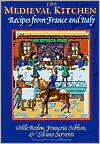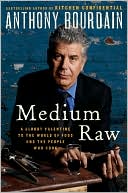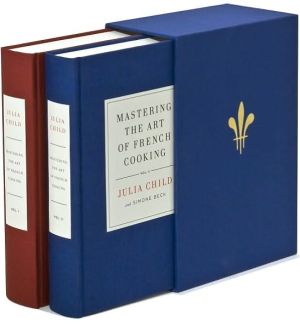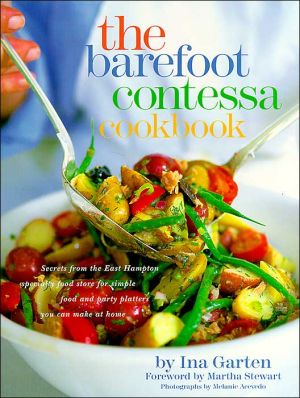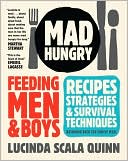The Medieval Kitchen: Recipes from France and Italy
Perhaps a pumpkin soup to start, and sugared dumplings; for the fish course, sole poached in bitter oranges, or, for the more daring palate, grilled brochettes of eel; the main course and piéce de résistance will be the roast wild boar in spiced sauce, with saffron asparagus, minced leeks, and fresh herbed fava beans as accompaniments; and for dessert, an elegant apple mousse in almond milk.\ This is but a taste of The Medieval Kitchen, a delightful and enticing work in which historians,...
Search in google:
The Medieval Kitchen is a delightful work in which historians Odile Redon, Françoise Sabban, and Silvano Serventi rescue from dark obscurity the glorious cuisine of the Middle Ages. Medieval gastronomy turns out to have been superb—a wonderful mélange of flavor, aroma, and color. Expertly reconstructed from fourteenth- and fifteenth-century sources and carefully adapted to suit the modern kitchen, these recipes present a veritable feast. The Medieval Kitchen vividly depicts the context and tradition of authentic medieval cookery."This book is a delight. It is not often that one has the privilege of working from a text this detailed and easy to use. It is living history, able to be practiced by novice and master alike, practical history which can be carried out in our own homes by those of us living in modern times."—Wanda Oram Miles, The Medieval Review"The Medieval Kitchen, like other classic cookbooks, makes compulsive reading as well as providing a practical collection of recipes."—Heather O'Donoghue, Times Literary Supplement Heather O'Donoghue With a very good introduction on such matters as etiquette, rules on fasting and feast days, and the role of drink at a banquet, The Medieval Kitchen, llike other classic cookbooks, makes compulsive reading as well as providing a practical collection of recipes. -- Times Literary Supplement
\ The Medieval Kitchen\ \ \ \ Recipes from France and Italy\ \ \ \ By Odile Redon Francoise Sabban Silvano Serventi\ \ \ University of Chicago Press\ \ \ \ Copyright © 2003\ \ University of Chicago\ All right reserved.\ \ ISBN: 0-226-70685-0\ \ \ \ \ \ Chapter One\ \ \ 31. Chicken with Fennel\ Chicken with fennel\ Take the chickens,\ cut them up, fry\ them, and when\ they are fried add\ the quantity of\ water you prefer;\ then take "beards"\ of fennel, "beards"\ of parsley, and\ almonds that have\ not been skinned;\ and chop these\ things well, mix\ them with the\ liquid from the\ chickens, and boil\ everything, then\ pass through a\ sieve. Add it to the\ chickens, and add\ the best spices you\ can get.\ This chicken recipe, with its tan and green sauce and its subtle\ flavor of fennel, is remarkable. It is another light dish that would\ not be out of place on the most inventive of modern menus.\ 1 free-range chicken\ 2/3 cup (100 g) unblanched\ almonds\ a handful of fennel or dill\ leaves\ a handful of parsley\ 2 cups (1/2 liter) water\ scant 1/2 teaspoon fine spices\ (see below)\ 2 tablespoons lard or oil\ salt\ Cut the chicken into serving pieces and pat dry. Melt the lard in\ acasserole over medium-high heat and brown the chicken. When it is\ golden brown, add the water and salt to taste. Lower the heat and\ simmer, covered, for 40 to 45 minutes or until tender.\ Meanwhile, wash and thoroughly dry the herbs. Grind the almonds\ finely in a blender or food processor, then add the herbs and blend\ to a paste.\ Remove the chicken from the casserole and keep it warm in a very\ low oven, covered loosely with aluminum foil.\ Add the almond mixture to the casserole and reduce over medium\ heat until the sauce has thickened.\ Arrange the chicken on a serving platter and strain the sauce\ over the chicken. Sprinkle with the spices to taste and serve.\ \ 150. Spice Mixture\ Fine Spice Mixture\ Fine spices for all foods\ Take an onza of\ pepper and one of\ cinnamon and one\ of ginger, and half\ a quarter [onza] of\ cloves and a\ quarter of saffron.\ It is a good idea to have this mixture ready for those times when\ you feel like cooking medieval. The text edited by Frati is from the\ Venice region, but not necessarily from Venice itself, so we cannot\ be sure of the exact equivalent of the oncia, or onza in the usage\ of the source. We have done our best, however, to retain the correct\ proportions.\ 2 rounded tablespoons freshly\ ground black pepper (16g)\ 2 rounded tablespoons\ ground cinnamon (16g)\ 2 rounded tablespoons\ ground ginger (16g)\ 11/2 tablespoons saffron\ threads, loosely measured,\ crushed to a powder in a\ mortar or with your fingers\ (4g)\ 3/4 teaspoon ground cloves\ (2g)\ \ 68. Inside-Out Stuffed Fresh Sardines or Anchovies\ Stuffed anchovies and sardines\ To stuff anchovies\ or sardines, put\ them in hot water\ after having\ removed the heads\ and bones so that\ they are open\ along the back.\ Then grind\ marjoram,\ rosemary, sage,\ good spices,\ saffron, and the\ flesh of a few fish.\ Fill the anchovies\ or sardines with\ this stuffing so that\ the skin is next to\ the stuffing and the\ outside in. Then fry\ them in oil. They\ may be eaten with\ lemon juice.\ In your wildest culinary dreams did you ever imagine opening a fish\ from the back, removing the bones and head without piercing the\ belly skin, spreading the skin with a stuffing, and closing the fish\ so that the flesh is on the outside, and then frying it? Yet this is\ what the author of this recipe suggests-and other writers as well.\ Maestro Martino splits a suckling pig along the backbone, turns it\ inside out like a sock, and then roasts it (see recipe 50); an eel\ is renversee in Le Menagier de Paris, or rovesciata in Italian\ sources, then cooked flesh-side out.\ The recipe we have chosen here uses the same intimidating\ technique, but in this case for a rather smaller creature. Fish are\ often hard to identify on the basis of their names, which even today\ vary from region to region. In Nordic regions, it is generally\ herrings that go by the Latin name of allex or hallex. This and\ other recipes in the Liber de coquina link the terms allectes and\ sarde or sardelle; medieval Latin uses a number of words derived\ from allex and allicium for small fish of all kinds; modern Italian\ uses alice for anchovy: for all these reasons, we have adapted this\ recipe for sardines and anchovies. We believe that sardines were\ sold lightly salted to keep them better; this would explain why the\ recipe instructs us to place them in warm water before removing\ their heads and bones.\ It is hard to know what benefits medieval cooks would have seen\ in a preparation of this kind, but it is certainly true that fatty\ flesh (and this inside-out technique is used only for suckling pig\ and fatty fish) will render some of its fat when exposed to direct\ heat. And the results are excellent from the standpoint of flavor.\ We have not been entirely faithful to the original recipe: we\ remove the head and bones from the fish without soaking them in hot\ water, which would be pointless-indeed harmful-for fresh fish.\ 24 whole sardines or large\ anchovies, not cleaned by the\ fishmonger\ 10 ounces (300 g) boneless\ meat of fatty fish such as\ sardines, herring, or mackerel\ 1 teaspoon chopped fresh\ marjoram or oregano (or half\ as much dried)\ 1 teaspoon chopped fresh\ rosemary (or half as much\ dried)\ 2 leaves sage, chopped\ 1/4 teaspoon ground ginger\ 1/4 teaspoon freshly grated\ nutmeg\ 1/8 teaspoon freshly ground\ black pepper\ 3 or 4 threads saffron,\ crushed\ salt\ 2 tablespoons olive oil\ lemon wedges to serve\ Using a thin-bladed, extremely sharp knife, cut into the back of\ each sardine or anchovy, cutting along either side of the backbone\ to free the backbone from the rib cage. At the same time remove the\ heads and the innards, being careful not to pierce the skin. This\ will yield 2 fillets joined by the skin of the belly.\ With a pair of good tweezers remove the most obvious rib bones.\ Remaining bones will be very visible when the fish has been cooked\ and can be removed easily by each diner.\ Wash the fish thoroughly and dry them with paper towels. Sprinkle\ them inside and out with salt and pepper and set them aside while\ you prepare the stuffing.\ For the stuffing, puree the fish flesh, herbs, spices, and salt\ to taste in a food processor. Transfer to a bowl and refrigerate,\ along with the filleted fish, if you are not going to continue\ immediately; if your kitchen is warm, keep the stuffing on ice as\ you work.\ It will be easier to stuff the fish if you sew each one partially\ closed, to form a pocket, skin-side in, flesh-side out. Stuff the\ fish and complete sewing each one up the back, leaving a little\ stuffing protruding from where the head used to be. To make this\ process even easier, put the stuffing into a piping bag with a\ small, plain tube, and pipe the stuffing into each fish.\ Heat the olive oil over medium heat in a skillet, preferably\ nonstick. Saute the fish for 3 to 4 minutes on each side, then cover\ the pan, lower the heat, and cook for another 30 seconds or so.\ Before serving, insert a knife into one of the fish and make sure\ the stuffing is cooked through.\ Sprinkle with lemon juice and serve garnished with additional\ lemon wedges.\ \ 95. Crustless "Sienese" Tart\ Sienese tart\ Take twenty\ almonds and\ blanch them\ thoroughly, and\ pound them as fine\ as possible. Then\ take half a libra of\ sugar, twelve eggs,\ and a fogletta\ [about a cup] of\ milk, two quatani\ of cinnamon, and\ the proper amount\ of salt, and half a\ quarto of fresh\ probatura cheese,\ pounded until it\ need be pounded\ no more. Then\ spread a mold with\ butter, and then\ flour it, and put the\ mixture on top. And\ set the mold or pan\ far from the fire,\ covered, with a\ moderate fire. And\ note that you can\ put into the mixture\ a ladleful of\ lasagne cooked in\ good broth. And\ when it is cooked,\ put sugar and rose\ water on top.\ We chose this recipe because it is the only one in any of our\ sources to be called "Sienese." Although it is called a tartara,\ like many pies and tarts in this Neapolitan collection, it is very\ similar to a crustless flan or quiche. We can find nothing like it\ in the cooking of modern Siena, and, as we have noted (see recipe\ 8), provatura cheese comes from southern Italy.\ 10 almonds, blanched\ scant 1/2 cup (80 g) sugar\ 6 eggs\ 1 cup (1/4 liter) milk\ 2 tablespoons cream cheese,\ softened\ 1 teaspoon ground cinnamon\ a pinch salt\ For the topping\ 3 tablespoons (5 cl) rose\ water\ 1 tablespoon sugar\ Preheat the oven to 325 degrees F (160 degrees C).\ Grind the almonds in a clean spice or coffee grinder, or in a\ blender, together with the sugar and cinnamon. Place the ground\ almonds and sugar into a bowl; beat in the softened cheese, then the\ eggs one by one, and the milk. Taste the mixture and add salt as\ needed.\ Butter and flour a 6-inch (15-cm) souffle dish or other ovenproof\ mold, and pour in the mixture. Bake for about 45 minutes and set\ aside to cool.\ When cool, you may unmold it (carefully: it is fragile) or serve\ it from the dish. Before serving, sprinkle with sugar and rose\ water.\ \ 103. Summertime Cerulean Blue Sauce\ Sky-blue sauce for summer\ Take some of the\ wild blackberries\ that grow in\ hedgerows and\ some thoroughly\ pounded almonds,\ with a little ginger.\ And moisten these\ things with verjuice\ and strain through\ a sieve.\ Toward the end of summer, when blackberries are at their best, this\ cerulean blue sauce will add zest to your September meat dinners.\ The pectin in the berries helps the sauce set to a lovely\ midnight-blue jelly that is a visual foil and a delicious\ accompaniment to white meats such as veal and chicken.\ 1 quart (1 liter) blackberries\ 1/3 cup (50 g) unblanched\ almonds\ 2/3 cup verjuice, or a mixture\ of two parts cider vinegar to\ one part water\ 1/4-inch slice ginger, peeled\ salt\ Puree the blackberries in a food processor or food mill, and strain\ the juice, pressing to extract as much liquid as possible. In a\ mortar or in a blender, grind the almonds and ginger, then mix with\ the blackberry juice. Contact with the air will turn the mixture a\ dark blue.\ Add the verjuice and strain once more. Season with salt to taste.\ \ 122. Orange Omelette for Harlots and Ruffians\ How to make an orange omelette\ Take eggs and\ break them, with\ oranges, as many\ as you like; squeeze\ their juice and add\ to it the eggs with\ sugar; then take\ olive oil or fat, and\ heat it in the pan\ and add the eggs.\ This was for\ ruffians and brazen\ harlots.\ Johannes Bockenheim (or Buckehen) was cook to Pope Martin V and in\ the 1430s wrote a brief but highly original cookbook recently edited\ by Bruno Laurioux (see bibliography). This German, who lived at\ Rome, wrote as a professional, with telegraphic terseness and little\ detail; yet he was careful to specify the destined consumer of each\ recipe, pigeon-holed by social class-from prostitutes to princes-or\ by nationality: Italian, French, German from any of various\ provinces, and so forth.\ We cannot see why this omelette, which contains no meat and no\ seasoning other than sugar, should be particularly well suited to\ debauchees. Surely, it is flesh (further fired by spices) that\ enflames the flesh. This omelette can be safely tasted without\ running the risk of moral turpitude.\ Since medieval oranges were bitter, we suggest a blend of oranges\ and lemons. The sugar and the acidity of the juice prevent the eggs\ from completely setting, so this is more of a custardy cream that\ makes an unusual and very pleasant dessert.\ 6 eggs\ 2 oranges\ 1 lemon\ 2 tablespoons sugar\ 2 tablespoons olive oil\ salt\ Juice the oranges and the lemon. Beat the eggs, add the juice, the\ sugar, and salt to taste, and cook the omelette in olive oil. Serve\ warm.\ (Continues...)\ \ \ \ \ \ \ \ \ Excerpted from The Medieval Kitchen\ by Odile Redon Francoise Sabban Silvano Serventi\ Copyright © 2003 by University of Chicago.\ Excerpted by permission.\ All rights reserved. No part of this excerpt may be reproduced or reprinted without permission in writing from the publisher.\ Excerpts are provided by Dial-A-Book Inc. solely for the personal use of visitors to this web site.\ \
\ Heather O'DonoghueWith a very good introduction on such matters as etiquette, rules on fasting and feast days, and the role of drink at a banquet, The Medieval Kitchen, llike other classic cookbooks, makes compulsive reading as well as providing a practical collection of recipes. -- Times Literary Supplement\ \ \ \ \ Library JournalAn English-language edition of La Gastronomie au Moyen Age: 160 Recettes de France et d'Italie, published in Paris in 1993, this volume of medieval recipes adapted for the modern cook is both usable and informative. Redon Univ. of Paris, Franois Sabban L'Ecole des Hautes Etudes en Sciences Sociales, Paris, and Silvano Serventi, an independent researcher, have combined their knowledge of languages, food, and history to create this fascinating collection of 153 recipes, ranging from soups and pasta to meats, sauces, and desserts. Each recipe is presented in its original form, in translation, and adapted for modern cooks. A brief passage also explains the significance of the recipe and its relation to other dishes. Although it is not the only title covering medieval cookery see, e.g., Madeleine Cosman's Fabulous Feasts: Medieval Cookery and Ceremony, LJ 1/15/77, this well-organized and entertaining work is recommended for specialized food or medieval collections in large public and academic libraries.Mary Martin, CAPCON Lib. Network, Washington, DC\ \ \ BooknewsIn addition to over 100 recipes from manuscripts of the 14th and 15th centuries, revised for modern kitchen, reconstructs the culinary life of the period with details on such aspects as ingredients, spices, shopping, food preparation, feast days and the liturgical calendar, culinary skills, and table etiquette. Includes 12 color plates (to look at, not eat from). Translated from ditions Stock. Annotation c. by Book News, Inc., Portland, Or.\ \ \ \ \ Bernard O'DonaghueThe great majority of the recipes appear not only possible but positively tempting to cook and eat. With a very good introduction on such matters as etiquette, rules on fasting and feast days, and the role of drink at a banquet, The Medieval Kitchen, like other classic cookbooks, makes compulsive reading as well as providing a practical collection of recipes.\ —Times Literary Supplement\ \
